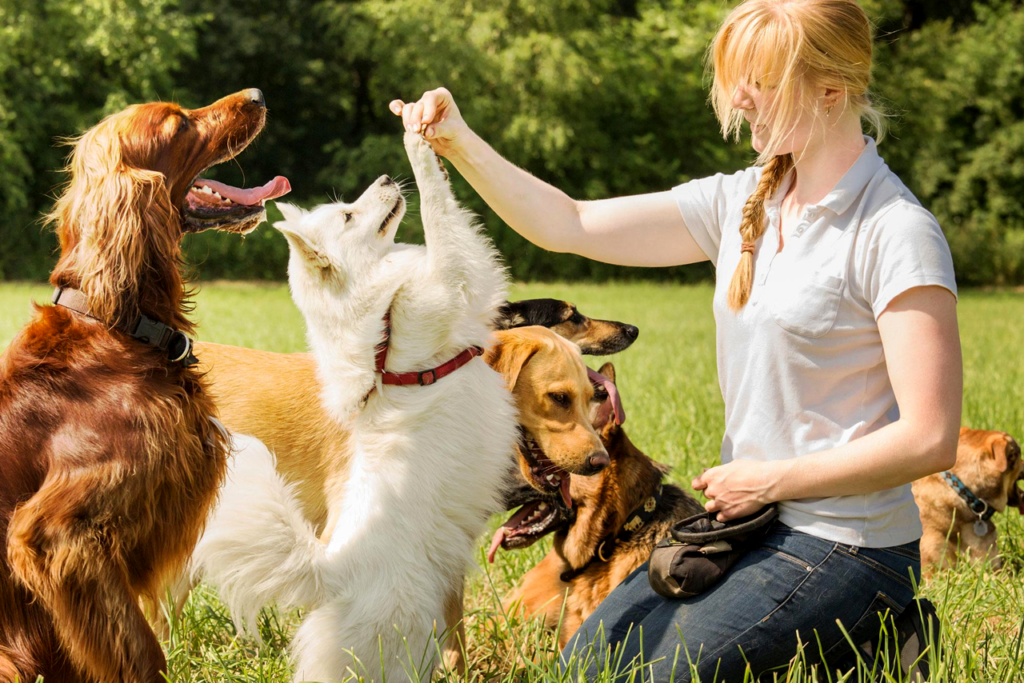
Training stubborn pets can be quite challenging, but with the right approach and techniques, it’s entirely possible to achieve positive results. Whether you’re dealing with a headstrong dog, a feisty cat, or any other pet displaying stubborn behavior, understanding their needs and employing effective training strategies is essential for fostering a harmonious relationship. In this comprehensive guide, we’ll delve into various tips and techniques to help you train your stubborn pets effectively.
Read More: The Positive Reinforcement in Pet Training
Introduction to Training Stubborn Pets

Understanding Stubborn Behavior in Pets
Stubborn behavior in pets can manifest in various ways, including ignoring commands, resisting training efforts, or exhibiting defiance. It’s crucial to recognize that stubbornness is often a result of miscommunication or lack of motivation rather than deliberate disobedience. By understanding the root causes of your pet’s stubborn behavior, you can tailor your training approach to address these underlying issues effectively.
Importance of Training for Pet Behavior
Training plays a pivotal role in shaping a pet’s behavior and ensuring their safety and well-being. By teaching them basic commands and establishing boundaries, pet owners can effectively manage their pet’s behavior and foster a strong bond based on mutual trust and respect. Moreover, training provides mental stimulation and helps prevent behavioral problems such as aggression, anxiety, and destructive behavior.
Building a Strong Relationship with Your Pet
Establishing Trust and Respect
Building a strong foundation of trust and respect is essential for effective training. Pets are more likely to respond positively to training when they trust and respect their owners. Establish yourself as a reliable and consistent leader by being patient, fair, and compassionate in your interactions with your pet.
Consistency in Communication
Consistency is key when communicating with your pet. Use clear, concise commands and cues, and reinforce them consistently to avoid confusion. Consistency helps your pet understand what is expected of them and reinforces desired behaviors over time.
Positive Reinforcement Techniques
Rewards-Based Training Methods
Positive reinforcement techniques involve rewarding desired behaviors with treats, praise, or affection. By focusing on positive reinforcement, you can motivate your pet to repeat good behavior. When your pet associates certain behaviors with positive rewards, they are more likely to engage in those behaviors willingly.
Using Treats Effectively
Treats can be powerful motivators during training, but it’s essential to use them strategically. Use high-value treats sparingly and vary rewards to keep your pet engaged. Additionally, make sure to fade out treats gradually once your pet has mastered a behavior to prevent over-reliance on food rewards.
Patience and Persistence
Dealing with Setbacks
Training stubborn pets can be challenging, and setbacks are inevitable. Instead of getting discouraged, view setbacks as opportunities for learning and growth. Identify the factors contributing to the setback and adjust your training approach accordingly.
Staying Calm and Composed
Pets are sensitive to their owner’s emotions, so it’s crucial to remain calm and composed during training sessions. Avoid frustration or anger, as this can undermine your pet’s trust and confidence. Keep training sessions short and positive, and end on a high note to maintain your pet’s motivation and enthusiasm.
Setting Clear Boundaries
Establishing Rules and Limitations
Clearly define boundaries and rules for your pet, and consistently enforce them. This helps your pet understand what is expected of them and reduces confusion. Be firm but fair when enforcing boundaries, and avoid making exceptions that can undermine your authority.
Consistency in Enforcing Boundaries
Consistency is key when it comes to enforcing boundaries. Be consistent in your expectations and responses to your pet’s behavior, and avoid sending mixed signals. Consistent enforcement of boundaries helps your pet understand the consequences of their actions and encourages them to follow the rules.
Professional Training Assistance

Seeking Help from a Professional Trainer
If you’re struggling to train your stubborn pets, consider seeking assistance from a professional trainer. Professional trainers have the expertise and experience to assess your pet’s behavior and develop a customized training plan tailored to their needs. They can also provide guidance and support to help you overcome training challenges and achieve your desired goals.
Finding the Right Training Program
Research different training programs and choose one that aligns with your pet’s temperament and learning style. Look for trainers who use positive reinforcement techniques and have experience working with stubborn pets. A good trainer will not only teach your pet obedience commands but also help strengthen the bond between you and your pet.
Understanding Your Pet’s Needs
Identifying Triggers for Stubborn Behavior
Take the time to understand what triggers your pet’s stubborn behavior, whether it’s fear, anxiety, or boredom. By addressing underlying issues, such as fear of certain stimuli or lack of mental stimulation, you can effectively manage your pet’s behavior and prevent future problems.
Tailoring Training Methods to Suit Your Pet
Every pet is unique, so it’s essential to tailor your training methods to suit their individual needs. Experiment with different techniques and approaches until you find what works best for your pet. Consider factors such as breed, age, temperament, and previous training experiences when developing a training plan.
Incorporating Play and Exercise
Using Playtime for Training
Incorporate training into your pet’s playtime to make it more engaging and enjoyable. Use toys and games to reinforce commands and encourage active participation. Interactive play not only provides physical exercise but also strengthens the bond between you and your pet.
Importance of Physical Activity
Regular exercise is essential for a pet’s physical and mental well-being. Make sure your pet gets plenty of opportunities for play and exercise to help prevent boredom and reduce stubborn behavior. Activities such as walking, running, and playing fetch provide both physical and mental stimulation for your pet.
Avoiding Punishment-Based Techniques
Negative Effects of Punishment on Pet Behavior
Punishment-based techniques can have detrimental effects on a pet’s behavior and emotional well-being. Physical punishment, yelling, or harsh corrections can lead to fear, anxiety, and aggression in pets. Instead of focusing on punishment, focus on rewarding desired behaviors and redirecting or ignoring unwanted behaviors.
Building Trust Through Positive Reinforcement
Focus on building trust and positive reinforcement to encourage desired behaviors. By rewarding good behavior and ignoring or redirecting unwanted behavior, you can effectively shape your pet’s behavior without resorting to punishment. Positive reinforcement strengthens the bond between you and your pet and fosters a positive learning environment.
Celebrating Small Victories
Acknowledging Progress in Training
Celebrate small victories and milestones in your pet’s training journey. Whether it’s mastering a new command or overcoming a behavioral challenge, praise your pet for their efforts and progress. Positive reinforcement boosts your pet’s confidence and motivation, making them more eager to learn and participate in training sessions.
Encouraging Continued Improvement
Keep your pet motivated by setting new goals and challenges to work towards. By continuing to challenge and engage your pet, you can encourage continued improvement and growth. Adjust your training goals as your pet progresses and celebrate each milestone along the way.
Consistency in Training
Importance of Regular Training Sessions
Consistency is key when it comes to training your pet. Schedule regular training sessions and stick to them, even when it’s challenging or time-consuming.
Incorporating training into daily routines
Integrate training into your pet’s daily routines to reinforce good behavior consistently. Use meal times, walks, and play sessions as opportunities for training and reinforcement.
Addressing Specific Behavioral Issues
Dealing with aggression or fearfulness
If your pet exhibits aggression or fearfulness, seek professional help to address these issues safely and effectively. Avoid confrontational or punitive techniques, as these can escalate the problem.
Seeking specialized training for specific issues
For complex or persistent behavioral issues, consider seeking specialized training or behavioral therapy. A qualified professional can provide guidance and support tailored to your pet’s needs.
Patience with Older Pets
Adjusting training techniques for senior pets
Older pets may require adjustments to their training techniques due to age-related changes in behavior or physical abilities. Be patient and understanding, and adapt your approach to accommodate their needs.
Understanding limitations and adapting expectations
Recognize and accept your older pet’s limitations, and adjust your expectations accordingly. Focus on maintaining their quality of life and providing them with love and support as they age.
Maintaining Training Beyond the Basics

Continuing education for pet owners
Stay informed about the latest training techniques and developments in pet behavior science. Continuously educate yourself to ensure you’re providing the best possible care and training for your pet.
Advanced training techniques for ongoing improvement
Once your pet has mastered the basics, challenge them with more advanced training techniques and activities. Keep training sessions varied and engaging to prevent boredom and stimulate their minds.
Read More: The Benefits of Training Your Pet
The Final Words
Training stubborn pets requires patience, consistency, and a deep understanding of your pet’s needs and behavior. By building a strong relationship based on trust and respect, using positive reinforcement techniques, and seeking professional assistance when needed, you can effectively train your pet and foster a harmonious bond that lasts a lifetime.








2 Comments